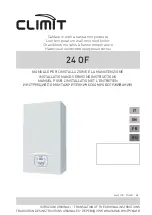
ENGLISH
14
- Press the “combustion analysis” button a third time to reach the num-
ber of revolutions that corresponds to the minimum output (table 2).
- Check the CO
2
value: (table 5) if the value does not comply with the
indications in the table act on the gas valve min adjustment screw
(fig. 46).
- To exit the “combustion analysis” function turn the command knob.
- Extract the gases analysis probe and refit the plug.
- Close the instrument panel and reassemble the shell.
The “combustion analysis” function automatically deactivates if the
card generates an alarm. In the event of a fault during the combustion
analysis phase, carry out the reset procedure, acting on the mode se-
lector as described in section 4.4.
Table 1
Maximum domestic hot
water fan rotations
Methane
gas (G20)
Liquid gas
(G31)
28 C.S.I.
61
61
rpm
Table 2
Minimum number of fan
rotations
M e t h a n e
gas (G20)
Liquid gas
(G31)
28 C.S.I.
12
15
rpm
Table 2a
Minimum number of fan
rotations in case of collective
smoke pipes under pressure
Methane
gas (G20)
Liquid gas
(G31)
28 C.S.I.
18
19
g/min
Table 3
Maximum number of
heating fan rotations
Methane
gas (G20)
Liquid gas
(G31)
28 C.S.I.
45
45
rpm
Table 4
Max CO
2
Methane
gas (G20)
Liquid gas
(G31)
28 C.S.I.
9.0
10.0
%
Table 5
Min CO
2
Methane
gas (G20)
Liquid gas
(G31)
28 C.S.I.
9.0
10.0
%
Table 6
Slow ignition
Methane
gas (G20)
Liquid gas
(G31)
28 C.S.I.
33
33
%
4.8 Gas conversion (fig. 47)
It is easy to transform gas from o
ne family to gas belonging to another
family even with the boiler installed.
This job must be done by professionally quali
fi
ed personnel only.
The boiler is supplied to run on natural gas (G20) – see the product
rating plate for details.
The boiler can be transformed to use propane gas using a special kit.
Follow the instructions given here below for disassembly:
- Switch off the power to the boiler and turn off the gas cock.
- Remove the panel and casing.
- Lift up and rotate the instrument panel.
- Open the air box cover.
- Unscrew the screws fastening the silencer (
A
) and remove it.
- Disconnect the mixer gas ramp. Unscrew the clamp screws and
relative mixer springs to fan and then remove it.
- Loosen the plastic Venturi (
B
) by levering from under the teeth (BE
CAREFUL NOT TO FORCE THEM) and press from the opposite
side until it is completely extracted from the aluminium shell.
-
Replace the plastic Venturi with the one contained in the kit.
- Reassemble the mixer with the
fl
ap in a horizontal position and
the spacer springs placed at 120° as shown in the
fi
gure.
- Reassemble gas ramp working vice versa.
- Switch on the power to the boiler and turn on gas cock again.
- Check the number of times the fan turns.
- Fill in and stick on the accompanying transformation data label.
- Close the air box cover.
- Close up the instrument panel again.
- Reassemble the casing and panel.
Programme the “Gas type” parameter and regulate the boiler fol-
lowing the instructions in the “Adjustments” section.
Transformation must be done by quali
fi
ed personnel only.
After completing transformation, regulate the boiler again
following instructions given in the speci
fi
c paragraph and
apply the new identi
fi
cation label from the kit.
Check that
fl
ap and Clapet are working correctly (all open
at rated
fl
ow, all closed at minimum
fl
ow)
RANGE RATED
This boiler can be adapted to the heating requirements of the system,
in fact it is possible to set the maximum delivery for heating operation
of the boiler itself:
- switch off the power supply
- setting the heating water temperature selector at the maximum value
- remove the shell
- turning the instrument panel towards you
- unscrew the two screws of the small cover on the electronic board to
have access to the terminals
- insert JP1 jumper
- power up the boiler.
The display shows “ADJ” for about 4 sec.: it is then possible to change
the maximum heating value by means of the heating water temperature
selector and the CO button in order to set and confirm the desired
value.
The icon
will appear on the display.
Finish the procedure by removing the jumper JP1 to store the set
values.
Once the desired output (maximum heating) has been set, note the
value on the table on the back cover.
For subsequent controls and adjustments, refer to the set value.
The calibration does not entail the ignition of the boiler. By rota-
ting the heating setpoint selector knob, the value expressed in
hundreds (e.g. 25 = 2500 rpm) is automatically displayed.
The boiler is supplied with the adjustments shown in the table.
Depending on plant engineering requirements or regional flue gas
emission limits it is, however, possible to modify this value, referring
to the graphs.
CO s.a. curve (Qnheating)
0
10
20
30
40
50
60
70
80
90
100
110
120
130
140
150
160
170
180
190
200
210
220
230
240
2
4
6
8
10
12
14
16
18
20
22
24
26
28
30
HTG curve (Qnheating)
F
an rotat
ions
(rpm
)
Heat output (kW)
CO emissions s.a. (p.p.m.)
Heat output (kW)
800
1200
1600
2000
2400
2800
3200
3600
4000
4400
4800
5200
5600
6000
6400
2
4
6
8
10
12
14
16
18
20
22
24
26
28
30















































